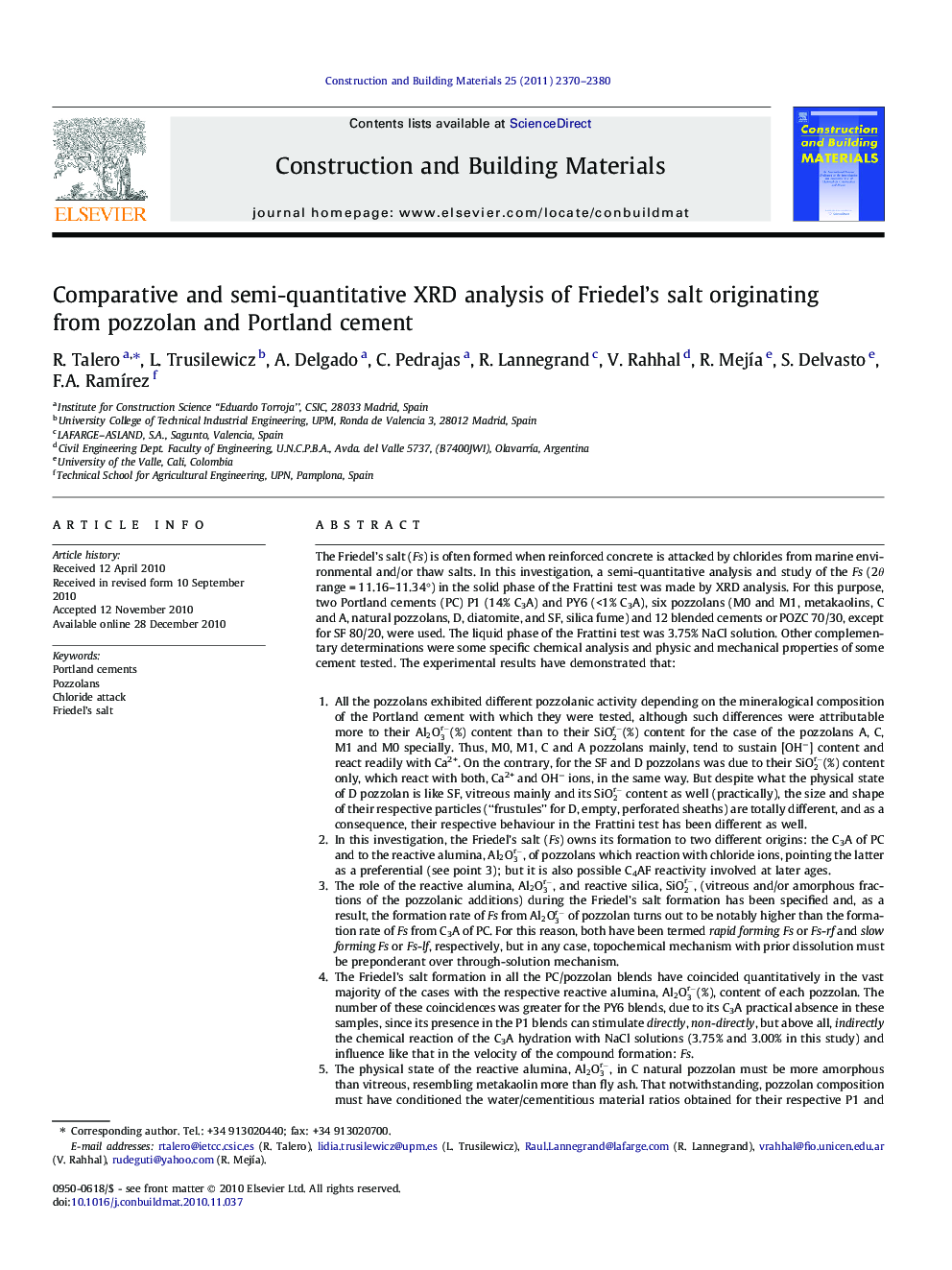| کد مقاله | کد نشریه | سال انتشار | مقاله انگلیسی | نسخه تمام متن |
|---|---|---|---|---|
| 259276 | 503631 | 2011 | 11 صفحه PDF | دانلود رایگان |

The Friedel’s salt (Fs) is often formed when reinforced concrete is attacked by chlorides from marine environmental and/or thaw salts. In this investigation, a semi-quantitative analysis and study of the Fs (2θ range = 11.16–11.34°) in the solid phase of the Frattini test was made by XRD analysis. For this purpose, two Portland cements (PC) P1 (14% C3A) and PY6 (<1% C3A), six pozzolans (M0 and M1, metakaolins, C and A, natural pozzolans, D, diatomite, and SF, silica fume) and 12 blended cements or POZC 70/30, except for SF 80/20, were used. The liquid phase of the Frattini test was 3.75% NaCl solution. Other complementary determinations were some specific chemical analysis and physic and mechanical properties of some cement tested. The experimental results have demonstrated that:1.All the pozzolans exhibited different pozzolanic activity depending on the mineralogical composition of the Portland cement with which they were tested, although such differences were attributable more to their Al2O3r-(%) content than to their SiO2r-(%) content for the case of the pozzolans A, C, M1 and M0 specially. Thus, M0, M1, C and A pozzolans mainly, tend to sustain [OH−] content and react readily with Ca2+. On the contrary, for the SF and D pozzolans was due to their SiO2r-(%) content only, which react with both, Ca2+ and OH− ions, in the same way. But despite what the physical state of D pozzolan is like SF, vitreous mainly and its SiO2r- content as well (practically), the size and shape of their respective particles (“frustules” for D, empty, perforated sheaths) are totally different, and as a consequence, their respective behaviour in the Frattini test has been different as well.2.In this investigation, the Friedel’s salt (Fs) owns its formation to two different origins: the C3A of PC and to the reactive alumina, Al2O3r-, of pozzolans which reaction with chloride ions, pointing the latter as a preferential (see point 3); but it is also possible C4AF reactivity involved at later ages.3.The role of the reactive alumina, Al2O3r-, and reactive silica, SiO2r-, (vitreous and/or amorphous fractions of the pozzolanic additions) during the Friedel’s salt formation has been specified and, as a result, the formation rate of Fs from Al2O3r- of pozzolan turns out to be notably higher than the formation rate of Fs from C3A of PC. For this reason, both have been termed rapid forming Fs or Fs-rf and slow forming Fs or Fs-lf, respectively, but in any case, topochemical mechanism with prior dissolution must be preponderant over through-solution mechanism.4.The Friedel’s salt formation in all the PC/pozzolan blends have coincided quantitatively in the vast majority of the cases with the respective reactive alumina, Al2O3r-(%), content of each pozzolan. The number of these coincidences was greater for the PY6 blends, due to its C3A practical absence in these samples, since its presence in the P1 blends can stimulate directly, non-directly, but above all, indirectly the chemical reaction of the C3A hydration with NaCl solutions (3.75% and 3.00% in this study) and influence like that in the velocity of the compound formation: Fs.5.The physical state of the reactive alumina, Al2O3r-, in C natural pozzolan must be more amorphous than vitreous, resembling metakaolin more than fly ash. That notwithstanding, pozzolan composition must have conditioned the water/cementitious material ratios obtained for their respective P1 and PY6 blended cements (a finding that could be used in the future for speedy, easy, reliable, reproducible and inexpensive characterization of natural and artificial pozzolans, and logically for this purpose, its previous physics-chemical analysis, Frattini test at 2 and/or 7 and/or 28 days-age and/or mechanical strengths will also be previously needed), as well as its specific pozzolanic activity.
Research highlights
► Pozzolanic activity of pozzolans in sodium chloride solution.
► Friedel’s salt originated from two origins: Al2O3r- of pozzolans and C3A of PC.
► Formation rate of Friedel’s salt from Al2O3r- is notably higher than for C3A origin.
► Friedel’s salt amount formed in PC blends is direct proportional to the Al2O3r- content of their pozzolan.
Journal: Construction and Building Materials - Volume 25, Issue 5, May 2011, Pages 2370–2380